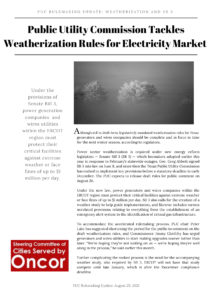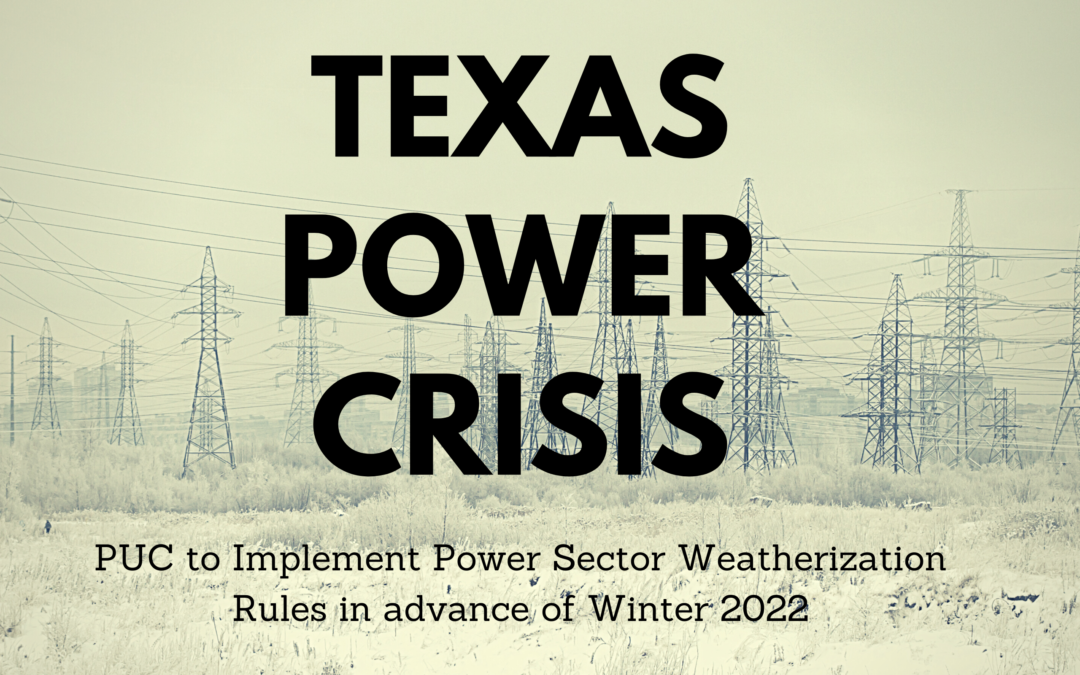
The OCSC has prepared an update that summarized weatherization rulemaking.
Power sector weatherization is required under new omnibus legislation adopted in response to February’s statewide outages.
________________________________________________
Athough still incomplete, legislatively mandated weatherization rules for Texas generators and wires companies should be finalized and in force in time for the next winter season.
That’s the word from state regulators, who expect to release draft rules this week. Power sector weatherization is required under new omnibus legislation — Senate Bill 3 (SB 3) — which lawmakers adopted in response to February’s statewide outages. Gov. Greg Abbott signed SB 3 into law on June 8, and since then the Texas Public Utility Commission has rushed to implement the bill’s weatherization provisions before a statutory deadline in early December.
Under the new law, power companies within the ERCOT region must protect their critical facilities against extreme weather or face fines of up to $1 million per day. SB 3 also calls for the creation of a weather study to help guide implementation, and includes various unrelated provisions relating to everything from the establishment of an emergency alert system to the identification of critical gas infrastructure.
To accommodate the accelerated rulemaking process, PUC chair Peter Lake has suggested shortening the period for the public to comment on the draft weatherization rules, and Commissioner Jimmy Glotfelty has urged generators and wires utilities to start making upgrades sooner rather than later. “We’re hoping they’re not waiting on us — we’re hoping they’re well along in the process,” he said earlier this month.
Further complicating the rushed process is the need for the accompanying weather study, as also required by SB 3. ERCOT will not have that study compete until late January, which is after the December compliance deadline.
To work around the problem, PUC commissioners have announced plans to implement the SB 3 weatherization mandates in two steps. The first step begins with the agency fashioning a limited set of rules by December 1 that will include broad requirements for generators and wires companies to correct any weatherization deficiencies identified during the serious winter storms of 2011 and 2021. PUC commissioners also have discussed implementing best-practices
Then, in 2022, the PUC will implement the second step: the creation of more granular weatherization regulations that correspond with various extreme weather risk probabilities. ERCOT will identify these specific risk probabilities through the weather study, which the organization is conducting in coordination with the state climatologist and private vendors. ERCOT officials say the study will include hourly weather data going back more than 100 years and will cover several discrete regions of the state. The study should be complete by late January.
SB 3 also gives ERCOT and the PUC new enforcement authority. That is, unlike legislation adopted after statewide outages in 2011, SB 3 allows for fines of up to $1 million per day for violations. The legislation also directs ERCOT to conduct inspections, and officials have said that they may require affidavits of compliance from plant owners and conduct spot checks as the new process gets underway.
Operators of generation plants have stated that in order to weatherize their plants, they will need to install windbreaks, install heated boxes around sensitive gauges and equipment, and make other technical adjustments. The most costly aspects of such upgrades arise from hiring extra workers or paying overtime, as opposed to the cost of purchasing actual equipment, according to plant owners. Many of the installed upgrades also are seasonal and temporary in nature and, as such, plant operators must wait until the cooler months to complete them.
SB 3 also directs the Railroad Commission to implement weatherization rules for critical natural gas units. However, the Railroad Commission has substantially more time to draft those rules in order to allow first for the completion of a supply chain study to identify critical infrastructure.
You can read more about the implementation of SB 3’s weatherization rules, here.

